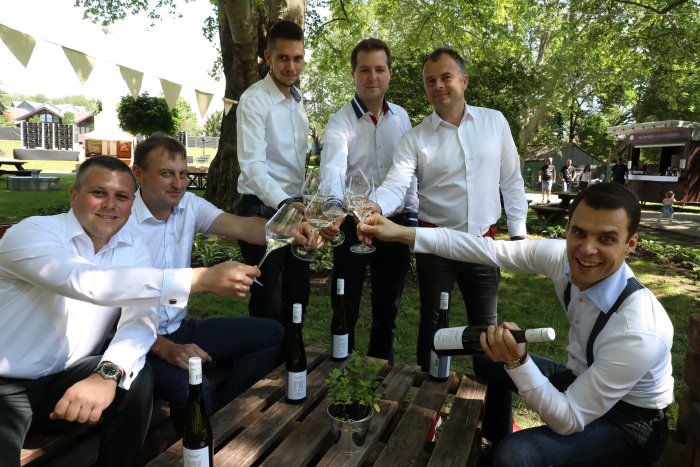Brand Building: 2019 Looking Good Thus Far

The fall tasting season has sparked into action, with plenty going on beyond the walls of the Buda Castle, site of the ever-popular Budapest Wine Festival that this year took place on the relatively early date of September 3-6.
Vintners from the PH-Érték wine association.
The big event was preceded by Winelovers River Night Vol.3, a kind of back-to-school cruise on the Budapest boat, which featured the wines of three associations that jointly promote the everyday, easy-drinking wines of their respective regions: Villányi REDy, BalatonBor and PH-Érték.
It is great to see so much cooperation between Hungarian winemakers, which flies in the face of the oft-held assumption that Magyar vintners see the wines made by their neighbors as the competition and not the wines coming from the wider world. Building brands and strong regional identity is definitely the way forward.
PH-Érték comprises six vintners/wineries from the Pannonhalma wine region: Cseri Pincészet, Hangyál Pincészet, Herold Pince, Pécsinger Szőlőbirtok, Tar Pincészet and Pannonhalmi Apátsági Pincészet.
They produce blends based on a 50% backbone of the region’s flagship Riesling grape (Rajnai Rizling in Hungarian, liteally Rhine Riesling, which differentiates it from the unrelated Olaszrizling grape).
The rest can come from any of Olaszrizling, Chardonnay, Pinot Blanc and Királyleányka, as well as the aromatic varieties of Fűszeres Tramini (Gewurtztraminer) and Sauvignon Blanc, although the latter two cannot contribute more than 30% to the blend.
PH-Érték is a clever play on words: Érték means “value” and PH refers to Pannonhalma, but can be interpreted as referring to the region, the relatively high PH value coming from its limestone soils, and the cultural values of the region.
Zesty Fresh
All of these tank-made reductive wines from the 2018 vintage (the first year of PH-Érték production) nicely captured the cool, zesty freshness of this predominantly white wine region in Hungary’s northwest.
While Pannonhalmi Apátság (the winery of the monastery of Pannonhalma) is a terrific producer, with a cutting-edge, gravity-fed winery tucked into the hill, under the majestic monastery, the project shows that there are other producers of high quality wine in the region and gives them a wider audience.
A visit to the monastery’s winery in the town of Pannonhalma is a must, but do also visit Nyúl, whose cellar rows evoke a Middle Earth vibe. The upcoming Cseri, which also impresses with its regular Riesling, Hangyál Pincészet and Tar Pincészet can all be found there. Pannonhalmi Apátság’s wine costs HUF 2,150 from its Budapest shop (Károlyi utca 19, District V), while all the wines can be purchased in a case of six for HUF 10,000 from Bortársaság’s two shops in Győr (but not, at the time of writing, from Budapest).
As we went to press for this issue, Tamás Illés, sales and marketing director of Pannonhalmi Apátsági Pincészet, said that the winery had harvested some 45% of the grapes, with the harvesting of the early-ripening Fűszeres Tramini and Királyleányka having started two weeks previously, followed by the Sauvignon Blanc.
“We are lucky this year; all the grapes are very healthy and ripe while retaining the acidity,” said Illés. Concerns had grown a few days previously when there had been rot (the winery’s Riesling crop was decimated last year by late-September, rot-inducing rains), but instead the grapes had shrunk and shriveled, making it easier to select the bad grapes out on the sorting table, by an optical sorting machine, as opposed to the more laborious and expensive visual and hand sorting.
Nevertheless, not all of the monastery’s prayers have been answered as it looks like the crop is coming in below par in terms of quantity at 25% down on the previous vintage.
“We expected a bit more, but it’s better than having big bunches with thin skins [that would make less concentrated wines],” said Illés.
‘Great Grapes’
Further west in Sopron, Franz Weninger spoke of “great grapes” in healthy and perfect shape.
“As quality is so high, we will do a lot of whole cluster fermentations,” he said. Whole bunch fermentation is considered to produce very high quality must and extra layers of complexity and structure, but it is necessary for the stems to also be perfectly ripe, not just the grapes, otherwise undesired green notes creep into the wine.
Not everything is perfect, however, admitted Weninger: he said that the vintage looks low on volume, with a yield of between 30 and 40% lower than last year.
In general, Hungary’s grape growers appear to be a pretty happy bunch regarding the prospects of this year’s vintage.
At a tasting of his newly launched wines from 2017 vintage, Gábor Merfelsz commented that if the fine weather continues at it has done, i.e. warm and dry with little in the way of dangerous downpours, then the southern region of Szekszárd will be in for an outstanding vintage.
One might think that the hot summer might have put severe heat stress on the grapes, and that the grapes might have ripened fast and furiously without the flavors benefitting from some serious hang time. However, the cool and very wet May slowed growth down and the rain was too early to cause serious disease threat to the fledgling grapes. Following that, it was constantly hot, but not too hot.
Doppio 2017 (a blend of Cabernet Franc and Merlot) was my pick of Merfelsz Pince’s latest releases – a real bargain at HUF 17,700 for a case of six directly from the winery, or HUF 3,700 a bottle from Selection.hu. They may not be indigenous grapes but who cares when the price is so good.
“In 2017 both Cabernet Franc and Merlot performed really well,” said Merfelsz, who is back to making his own wines after having worked with a winemaker for several years.
He likes to harvest his grapes quite late when the acidity isn’t too sharp. The concentration, complexity, and oak use is impressive in Doppio, while the Bikavér is nicely balanced and expressive (expect to pay HUF 15,000 for six). Merfelsz also makes a fine Turán and Nero Selection, but they will each set you back HUF 48,000 for half-a-dozen bottles.
SUPPORT THE BUDAPEST BUSINESS JOURNAL
Producing journalism that is worthy of the name is a costly business. For 27 years, the publishers, editors and reporters of the Budapest Business Journal have striven to bring you business news that works, information that you can trust, that is factual, accurate and presented without fear or favor.
Newspaper organizations across the globe have struggled to find a business model that allows them to continue to excel, without compromising their ability to perform. Most recently, some have experimented with the idea of involving their most important stakeholders, their readers.
We would like to offer that same opportunity to our readers. We would like to invite you to help us deliver the quality business journalism you require. Hit our Support the BBJ button and you can choose the how much and how often you send us your contributions.








